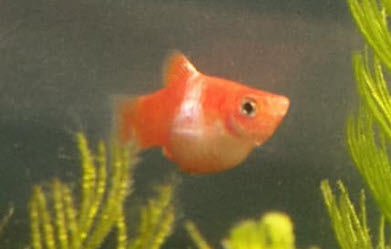
Tetrahymena is a single celled ciliated protozoan closely related to paramecium and epistylis. It can be found in the detritus of most aquariums. It can be very similar in appearance on the fish to columnaris, ich and epistylis. Like epistylis, tetrahymena is found in the detritus of most aquariums and feeds on bacteria in the water column. And like epistylis, tetrahymena CAN be either commensural on a fish (only uses the fish as an anchor) or it can be pathogenic, attacking the fish and causing bacteria filled lesions.
Tetrahymena tends to occur in livebearers while epistylis tends to occur in fish other than livebearers. Tetrahymena doesn’t stick out into the water column from the fish like epistylis does. Epistylis will from branching colonies on stalks and can stick out quite far into the water. Tetrahymena only occurs as single cells but can form a flat “colony” of cells on the skin of a fish. But to confuse the matters further, it is common to have both tetrahymena and epistylis on a fish.
The disease of epistylis is covered in this link:
10.2.4. Epistylis
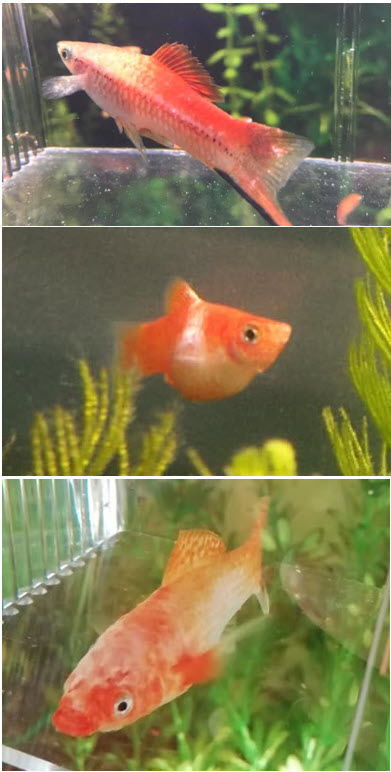
When the mulm and detritus build up or the bacterial count in the water column becomes high, tetrahymena becomes virulent. The high bacterial count in the water feeds the tetrahymena organism and it takes up immune system resources on the fish. This two pronged attack is difficult to combat. Tetrahymena attacks the skin of the fish and then burrows into the insides of the fish, often killing it rapidly. Once the tetrahymena is inside the fish it is virtually impossible to treat and the prognosis is not good.
Tetrahymena can present in many different appearances:
- It can be patchy gray or whitish areas that look like peeling skin. These white areas are commonly on top of the head of the fish or just in front of the dorsal fin.
- Like all skin protozoans it can produce patches of slime on the fish.
- Tetrahymena also commonly attacks the eyes and causes pop-eye and white eye (note ich doesn’t typically attack the eyes)
- Tetrahymena can also present as white spots somewhat like ich in appearance. But the tetrahymena spots are gray, not ceiling white like ich. Tetrahymena spots are also irregular in appearance while ich is a very round constant shape.
- Sometimes tetrahymena invades the external tissues of the fish and causes them to have translucent fluid filled blisters with raised scales (epidermal necrosis).
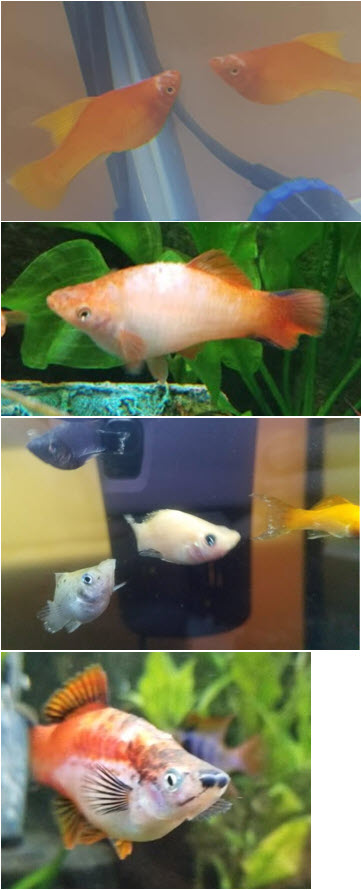
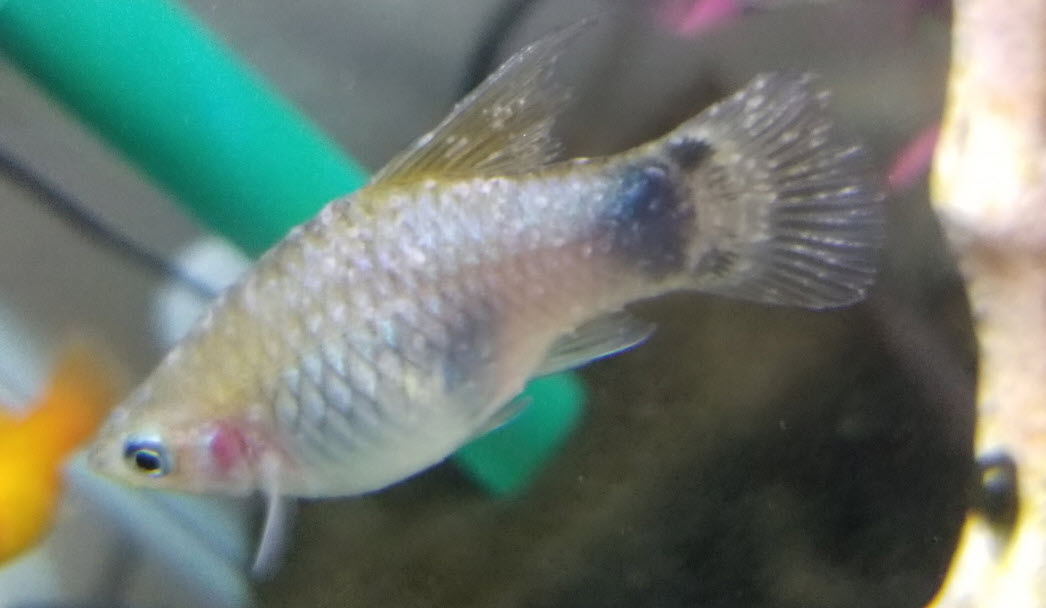
Tetrahymena commonly looks just like a case of saddleback, which is generally a bacterial infection caused by a columnaris. It is also common to have both tetrahymena and a bacterial infection going on. Which “came first” is immaterial as either can kill the fish. If there is a white patch high on the fish on the head or in front of the dorsal fin we recommend treating with an antibiotic in the food and only in the food.
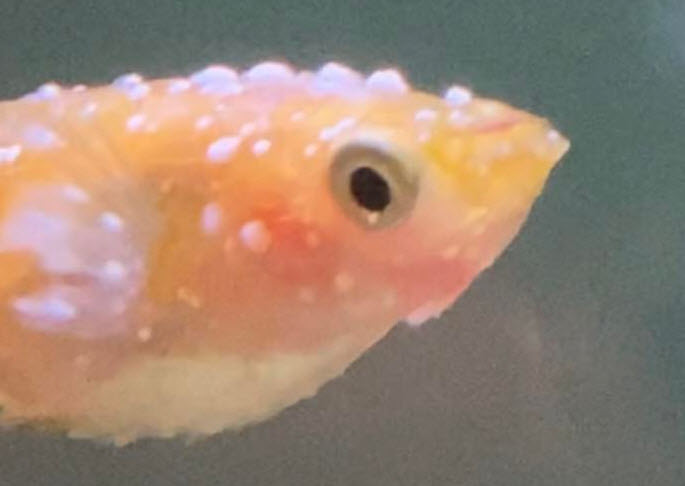
Tetrahymena can also resemble ich (Ichthyophthirius multifiliis) in many ways. Affected fish can sometimes be covered with white spot-like cysts on their flanks and fins. They may also exhibit such symptoms as heavy breathing, lethargy and clamped fins. This mimics ich. But ich is always over the entire body of the fish while tetrahymena tends to be on one area at a time. The “spots” of tetrahymena are much more irregular than ich, more translucent, and tend to be in clumps rather than evenly distributed like ich.
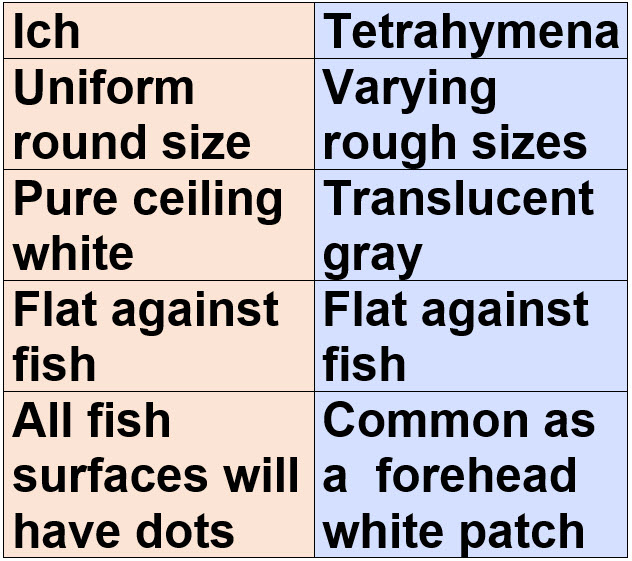
Swellings may develop in the muscles of the fish. Gray patches of mucous may be apparent, particularly on dark-colored fish such as black mollies. The spots may coalesce into fuzzy patches. Tetrahymena is most often found in guppies and livebearers. It is sometimes referred to as the “guppy killer” or “guppy disease”.
With guppies the symptoms of tetrahymena are rarely seen. The guppies just suddenly die. This is very common. The tetrahymena is only found if the dead guppies are examined via skin scrapings under a microscope. This is one of the reasons guppies require very clean, crystal clear water.
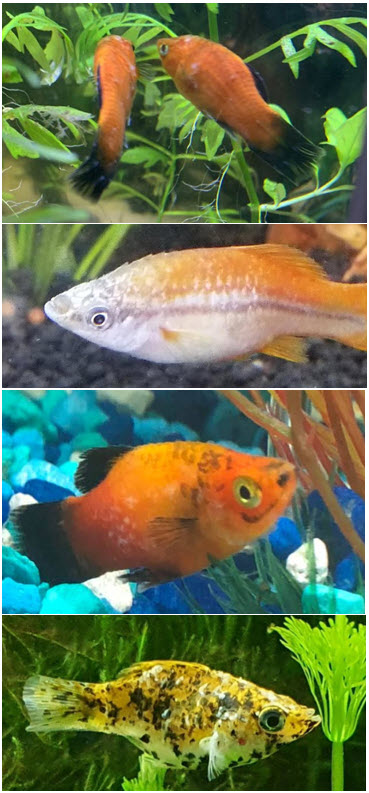
There are a whole series of protozoan diseases which can present themselves exactly like tetrahymena. These diseases include trichodina, chilodonella and costia. Occasionally epistylis will present just like this. The fact that the diseases are different is only found when microscope smears are taken of the skin.
Treating most skin protozoan diseases including tetrahymena can be done with a whole series of steps:
- Add lots of additional biofiltration (under-gravel, canister or sump) to filter out and thus kill the free swimming organisms. This added biofiltration also reduces the bacterial loading in the water which in turn allows the fish to devote more immune system resources to the pathogen.
- Change the filter media slowly over to a better media. Brightly colored pot scrubbers, foam and static K1 are very good media by testing. Ceramic rings, Matrix and lava rock are very poor media by those same tests.
- Add a formalin/malachite green medication (Ich-X, Rid-Ich Plus, Blue Planet White Spot Remedy and Mardel QuickCure) or a Copper based medication (Cupramine, Copper Power, Copper Aide or Copper Safe) to the water of the aquarium to kill the free swimming organisms.
- Do not put the fish in a hospital/quarantine tank
- Do not change out or clean the filter media.
- Do not raise the temperature of the tank
- Add a 24/7 UV sterilizer to kill the free swimming organisms and reduce the bacterial loading in the water which in turn allows the fish to devote more immune system resources to the pathogen.
- Added aeration always is helpful
When tetrahymena invades the tissues and cause translucent white patches (necrosis of the epidermis) and patchy “slime disease”, the organism becomes too deeply imbedded in the skin to be attacked by ich medications. And there is no internal medication effective against it. So death typically occurs.
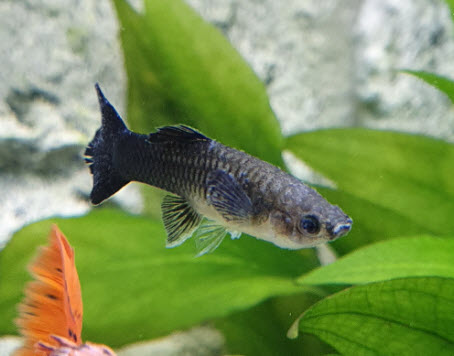
Compared to ich, tetrahymena causes death much more quickly and at a far higher rate. In some cases, an infected fish can appear healthy one day and be dead the next. Besides the limited time available for diagnosis, medications that work against ich or velvet tend to work poorly, if at all, against tetrahymena.
There is research which says a 3% salt bath (the salt concentration of the ocean), repeated every 24 hours is effective. Put the fish in a 3% salt bath for 30 seconds to ten minutes. When the fish loses equilibrium and rolls over, quickly return them to fresh water.
A liter of water is 1,000 grams. There are 5.69 grams of salt in a level teaspoon of salt. So a 3% solution is about 5 level teaspoons of salt per liter of water. Or 20 level teaspoons (roughly half a cup) per gallon of water in a tray. The exact concentration of salt isn’t too important, just make sure it is strong.
Tetrahymena is almost always is indicative of water with a high bacterial count and lots of organic matter in the water. High bacterial count indicates poor filtration. Poor filtration in turn can be caused by cleaning the filter media too often, having poor filter media or by having too little filter media. Adding much more biofiltration, a UV sterilizer and cleaning the aquarium substrate (NOT the filter!) well is often the only good solution to an outbreak of tetrahymena. Tetrahymena is rarely seen in aquariums with crystal clear water.
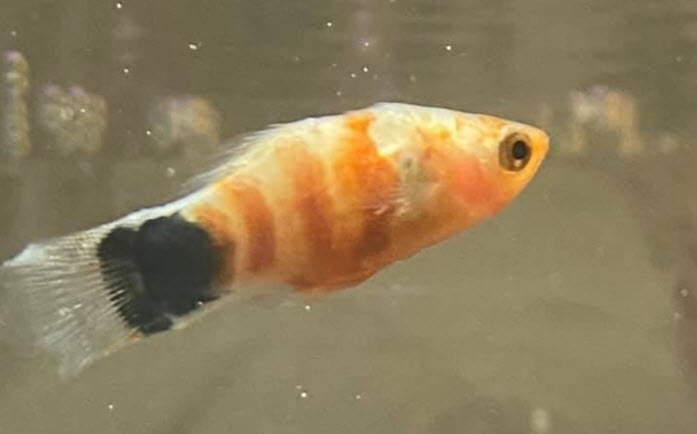
Treating Tetrahymena Indirectly with a Mature Filter
This is the confusing part of this, so I will try and make it as simple as possible. The tetrahymena organism is present in almost all tanks feeding on bacteria in the water. When the bacteria count in the water gets high, such as when a new tank and new filter are set up, tetrahymena can proliferate and end up on the fish. Once on the fish it can become pathogenic and erode the protective coating on the fish’s skin. This allows the tetrahymena and bacteria to enter the fish’s body and start septicemia (a bacterial infection).
With an old filter more than two months old or so the filter is “mature” and has a good coating of brown “gunk” on it. This brown gunk will have a ton of tetrahymena organisms (and other organisms much like tetrahymena) in it eating the bacteria in the water. The tetrahymena in the filter will eat so much of the bacteria in the water column that there will be not bacteria for tetrahymena organisms on a fish to eat and reproduce. So tetrahymena will not appear on a fish and cannot enter and kill the fish.
This disease prevention by an established, mature filter is a very important feature in all aquariums. It is why the experts keep emphasizing how a mature aquarium is so much more healthy than a newly set up aquarium. This is why it is so important for newcomers not to take things too rapidly. Add small numbers of small juvenile fish to any new aquarium. Go slow! And do not clean the filters until the flow slows down.
Epistylis and Tetrahymena
It is quite common to get both tetrahymena and epistylis in livebearers. Below are some fish which APPEAR to have both. But note without using a microscope one cannot be sure. These fish might also have columnaris as columnaris can also stick out into the water a short distance (the “column” in columnaris refers to the tall structures of bacteria). And all three can be seen in one fish, which gets really confusing.
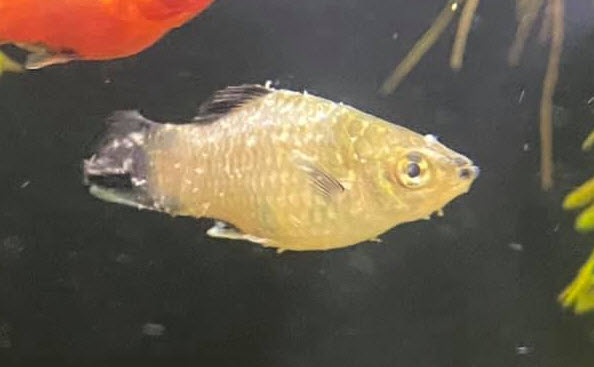
.
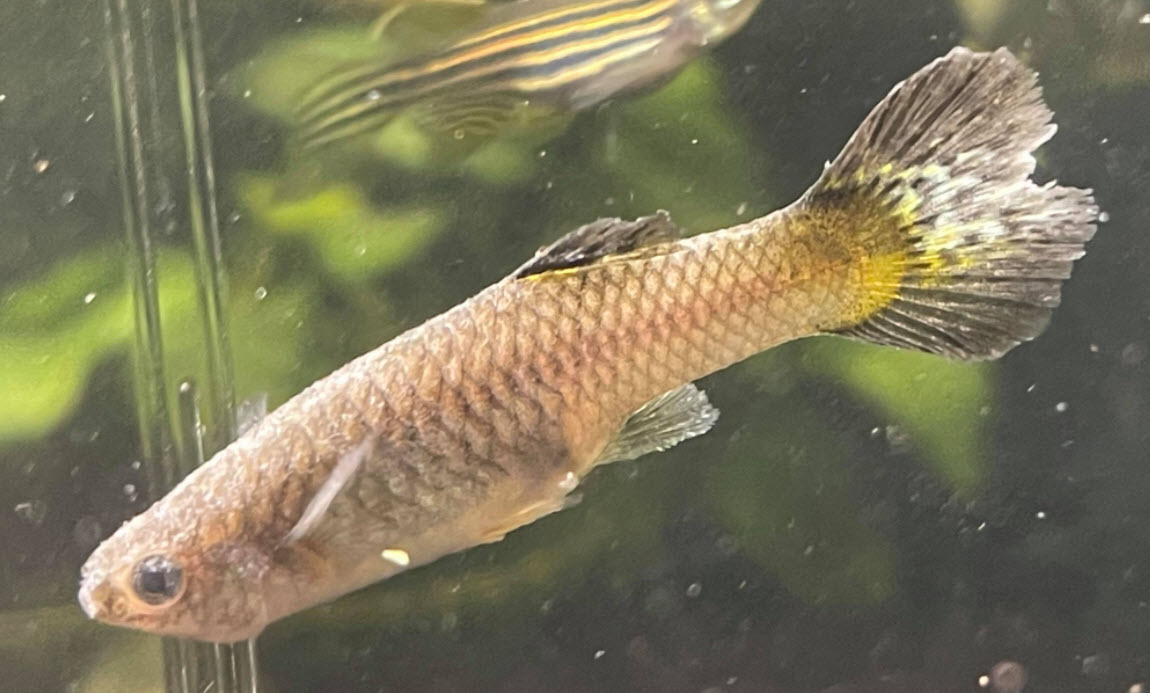
.
Return to Diseases Menu
Return to Skin Protozoans Menu
.
Aquarium Science Website
The chapters shown below or on the right side in maroon lead to close to 400 articles on all aspects of keeping a freshwater aquarium. These articles have NO links to profit making sites and are thus unbiased in their recommendations, unlike all the for-profit sites you will find with Google. Bookmark and browse!
.

Rose Weston says
Thank you so so much. I appreciate what you’ve done!
Archie says
Thank you David! This is the only article I have read about livebearer disease. I have raised several tanks of guppies and over the years found anecdotal evidences like you mentioned but I didn’t know why. Like I had tetrahymena happened to two of guppy tanks in two separate incidences. Yet when I posted on the Internet forums asking about why the sudden massive deaths of my heavily planted guppy tank and some guppies with white forehead. People will just ask common tank parameters like it can solve anything. After reading this article I understand it now.
Dave says
In reply to Izzy …. No, a human cannot get tetrahymena. The only fish disease which infects human is environmental mycobacteriosis (“Fish TB”)
Izzy says
Can a human become infected from Tetrahymena? Like if my fish have it and I am cleaning the tank, can I get sick from it?
Dave says
In reply to Amir …. Yes that CAN be due to tetrahymena. It also can be due to bacterial infections.
Amir says
The blood spots that sometimes look like blisters or in some guppies their scales have been removed and it looks like the flesh of the body is visible. I wanted to know if these symptoms can also be from Tetrahymena?
Darin Smith says
Thanks again Dave. It’s really hard to know what disease it is, as almost everything results in white spots or white patches. It might be fish TB, though I haven’t noticed any wasting in her…she is quite large and plump, and while shy, very energetic and in fact, aggressive. Your description and photos of tetrahymena seem the most similar to what I’m seeing, so far. I appreciate the advice & will leave out the Metroplex. I probably could (should) leave well enough alone, but it’s bothered me that the white patch and extra “pimples” came on so suddenly. Last night I figured I’d take a run at fishing her out so I could put her into a quarantine tank for observation (she hides so much in the display tank that it is difficult to see developments day to day). After uprooting a few sprigs of anacharis, I finally got her & put her in quarantine. Dosing paraguard in water and kanaplex in food just to see if it helps. Now I will just observe & see what happens. Either she will get worse, or better, or remain the same. As long as she doesn’t get worse, I will re-introduce her to the main tank after she has a nice retreat in the quarantine tank. It has already calmed her down, so I’m wondering if it is just stress or aggression related. For all I know, the boys are after her too much and she needs a break for her immune system to build back up.
Dave says
In reply to Darin ….. Antibiotic laced food isn’t going to hurt any inverts. Use only the Kanaplex and forget the Metroplex. Note if I were you I wouldn’t do anything. A two month old “pimple” could well be fish TB, which is untreatable. And your set up is excellent. So just let Mother Nature decide who is going to win the battle.
Darin Smith says
Thanks for this info. I have a female swordtail that 2 months ago developed a single pimple-like white spot near the caudal fin. She was also easily agitated & stressed, possibly having to do with a nearly complete pregnancy. After the fry came & she started to relax a bit, the “pimple” seemed to go down a bit, but never went away. I assumed at the time that it might be the beginning of lymphocystis, but it didn’t seem to progress. A day ago I saw her and she had a white patch in front of the dorsal fin–looking like saddleback. On closer inspection, I see the return of the white “pimple” near the caudal fin and a few other “pimples” (still retain normal color) on her sides. None of the other fish are showing symptoms. My water is very, very clear. I run pot-scrubbers in a Tidal 110 and the 20PPI foam in a Tidal 55 + 24/7 UV clarifier (in-tank Chinese special). I am considering trying to remove her into quarantine for closer inspection & feeding KanaPlex+MetroPlex laced food. Though she is next to impossible to catch–she is very wary of nets and even hides in the plants when she sees me. I am a little wary of using the medicine laced food in the whole tank because I have a number of invertebrates that would be extremely difficult to remove them all (8+ CPOs [breeding population], Amanos, 1 mystery snail & a handful of Japanese Trapdoor Snails). While the laced food is safer for inverts than dosing the whole tank, they subsist mostly on scraps even if I offer them their own food (which the livebearers happily try to eat as well).